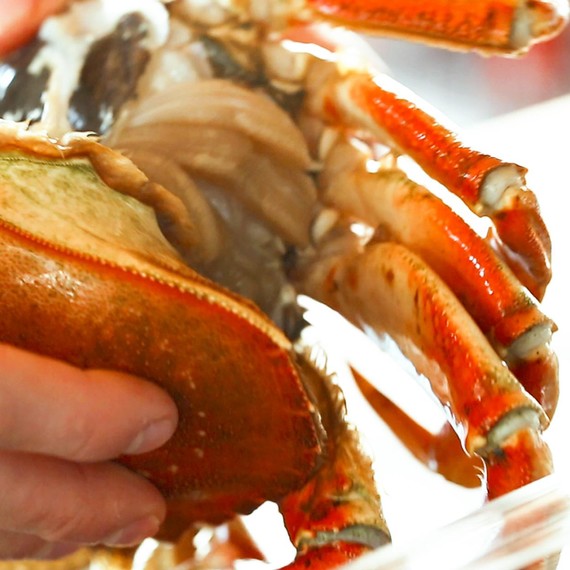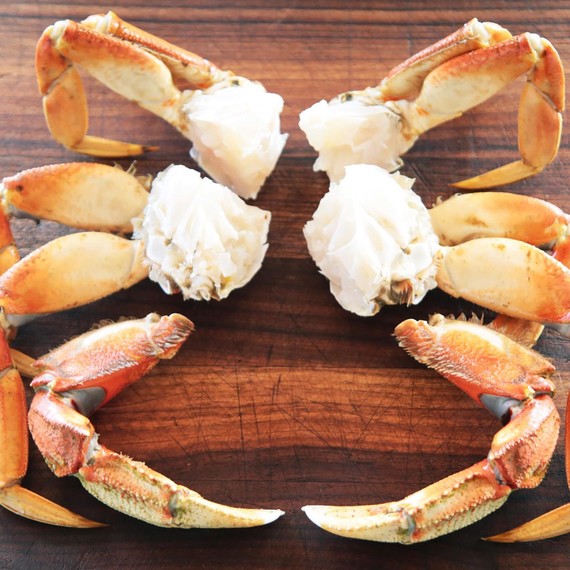أفضل طريقة لتنظيف سرطان البحر

في ChefSteps ، نحن عشاق ضخمة من سرطان البحر الطازج. بالنسبة لنا – وكثير من الأمريكيين – يأكل سرطان البحر طقوسًا لتناول الطعام في الصيف على قدم المساواة مع سمك السلمون المشوي ، والإسكافي التوت ، والذرة على قطعة خبز. وعلى الرغم من أننا قد نعيش على الساحل المقابل من نيو إنجلاند ، إلا أننا لا نزال نرغب في تجميع الطاقم والتوجه إلى الشاطئ في اتجاه منطقة شمال غرب المحيط الهادي تأخذ على متن سفينة. ليس في clambakes؟ هناك طن من طرق مذهلة للعمل السلطعون في ذخيرة صفة الطقس الحار الخاص بك. تُغمس الأرجل في الزبدة الموضحة أو صلصة الكوكتيل الكلاسيكية ، وتخلط مع المايونيز والأعشاب وتحضّر في لفائف الزبدة ، كما تستخدمها لتتحول إلى سلطة خضراء موسمية ، وتخلط في كراب كيك ، وترافق مع صلصة الميرفلدة القديمة من مارثا ، طبقة تحت البيض المسلوق. و Hollandaise للحصول على خففت على بنديكت الكلاسيكية ، أو محاولة وصفة Emeril لبيض Deviled مع سرطان البحر.
هنا في سياتل ، ونحن عادة ما تتغذى على سرطان البحر Dungeness – أن قشريات حلوة ، لحم أصلي إلى هذه المنطقة من العالم. ولكن إذا كان لديك إمكانية الوصول إلى Blue ، Stone ، وألاسكا سنو … فنحن نعتقد أنهم جميعًا يتمتعون بطعم لذيذ.
ومع ذلك ، فإن الخطوة الأولى لنجاح طبق سرطان البحر لذيذ ، هو معرفة كيفية تنظيف تلك القشريات.

1. Blanch في الماء المغلي لمدة 60 ثانية ، ثم البرد بسرعة. لا توجد طريقة حوله: إذا كنت تستخدم سرطان حي ، فستحتاج إلى إزالته قبل التنظيف. يمكنك استخدام أي طريقة ترغب في القيام بذلك ، ولكن يبدو أن شطف سريع لمدة 60 ثانية في الماء المغلي يؤدي المهمة. دونك السلطعون في الماء المثلج للتوقف عن الطهي.
2. قم بإزالة الغطاء وإزالة أي شيء غير اللحم. للقيام بذلك ، سترغب في البدء في الانسحاب من الجزء الخلفي من سرطان البحر أولا. إزالة الخياشيم ويستخرج الشجاعة داخل جسم السلطعون. القاعدة الجيدة هي إزالة أي شيء غير أبيض خالص (المادة البيضاء هي اللحم ، ويا يا فتى ، هل هو لذيذ).
3. شطف ، ونقب قبالة البطن. نحن نغسل سرطان البحر في وعاء من الماء المثلج ، ولكن يمكنك استخدام صنبور يعمل أيضًا.
4. قطع السلطعون إلى أرباع عن طريق تقسيم أسفل الوسط ، من الرأس إلى الذيل ، ثم قطع كل جانب في نصفين. اترك النصف الأمامي مع pincher (إذا كان لا يزال متصلاً ، فقد تسقط أحيانًا أثناء التنظيف) ، والنصف الخلفي مع آخر ساقين أو ثلاثة أرجل.
5. تبقى باردة حتى الحاجة.
نريد أن نرى أنه في العمل؟ شاهد الفيديو أدناه!

27.04.2023 @ 05:28
As an AI language model, I do not have a specific language or culture. However, I can provide a translation of the text into English:
At ChefSteps, we are huge fans of fresh seafood. For us – and many Americans – eating seafood is a ritual for summer dining, on par with grilled salmon, berry cobbler, and corn on the cob. And although we may live on the opposite coast of New England, we still want to gather the crew and head to the beach towards the Northwest Pacific region aboard a ship. Not into clambakes? There are tons of amazing ways to work lobster into your hot weather arsenal. Dip the legs in clarified butter or classic cocktail sauce, mix with mayo and herbs and prepare in butter rolls, use it to turn into a seasonal green salad, mix in crab cakes, and accompany with Marthas old-fashioned mirepoix sauce under boiled eggs. And Hollandaise for a light classic Benedict, or try Emerils recipe for Deviled Eggs with lobster.
Here in Seattle, we usually feed on Dungeness crab – sweet crustaceans, original meat to this region of the world. But if you have access to Blue, Stone, and Alaska Snow… we believe they all have a delicious taste.
However, the first step to a successful lobster dish is knowing how to clean those crustaceans.
1. Blanch in boiling water for 60 seconds, then cool quickly. Theres no way around it: if youre using live lobster, youll need to remove it before cleaning. You can use any method you want to do this, but a quick rinse for 60 seconds in boiling water seems to do the trick. Dunk the lobster in ice water to stop cooking.
2. Remove the cover and remove anything other than meat. To do this, youll want to start by pulling out the back of the lobster first. Remove the gills and extract the courage inside the lobsters body. The good rule is to remove anything other than pure white (the white substance is meat, and boy, is it delicious).
3. Rinse, and scrape off the belly. We wash the lobster in a bowl of ice water, but you can also use a running tap.
4. Cut the lobster into quarters by dividing it down the middle, from head to tail, then cutting each side in half. Leave the front half with the pincher (if still attached, it may fall off during cleaning), and the back